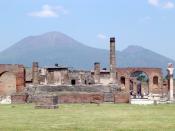In the city of Pompeii on the morning of August 24, 79 CE, everyday life was commencing as usual. The stirrings of the mountain in the distance went unnoticed until an explosion rocked the streets. Panic broke out as people tried to flee the city and parents made vain efforts to protect their children from the falling ash and rocks that would cover the city. The eruption of Mount Vesuvius did not just demolish a city, it wiped out an entire civilization.
Beginning in the year 62 CE, violent earthquakes rocked the region, warning of volcanic activity. The eruption, beginning that fateful August morning, lasted over 24 hours. The eruption was the first one ever recorded in history. An explosion came from the mountain and fine ash fell on the slopes. Then a Plinian column, composed of gas and ash, rose about 15 miles into the air before branching out like an umbrella to blanket the region.
According to Andrew Wallace-Hadrill, "It was not until around midnight that the first pyroclastic surges and flows occurred" ("Pompeii: Portents of Disaster"). A pyroclastic flow is a ground-hugging avalanche of pumice, rock fragments, hot ash, and volcanic gas. These can travel down the mountain at 100 miles an hour and meant certain death for the people in the region. Three cities were hit hard by the eruption - Stabiae, Herculaneum, and of course, Pompeii. The latter two were demolished, but Pompeii was unquestionably the hardest hit. It is hard to imagine the destruction that a volcanic eruption of this degree would cause (www.bbc.co.uk/history).
When Vesuvius erupted, ten feet of tephra covered Pompeii, asphyxiating many people. Tephra is composed of volcanic material deposited from the air. After this fell, the pyroclastic flows killed any remaining people of the region. Some people of Pompeii...


